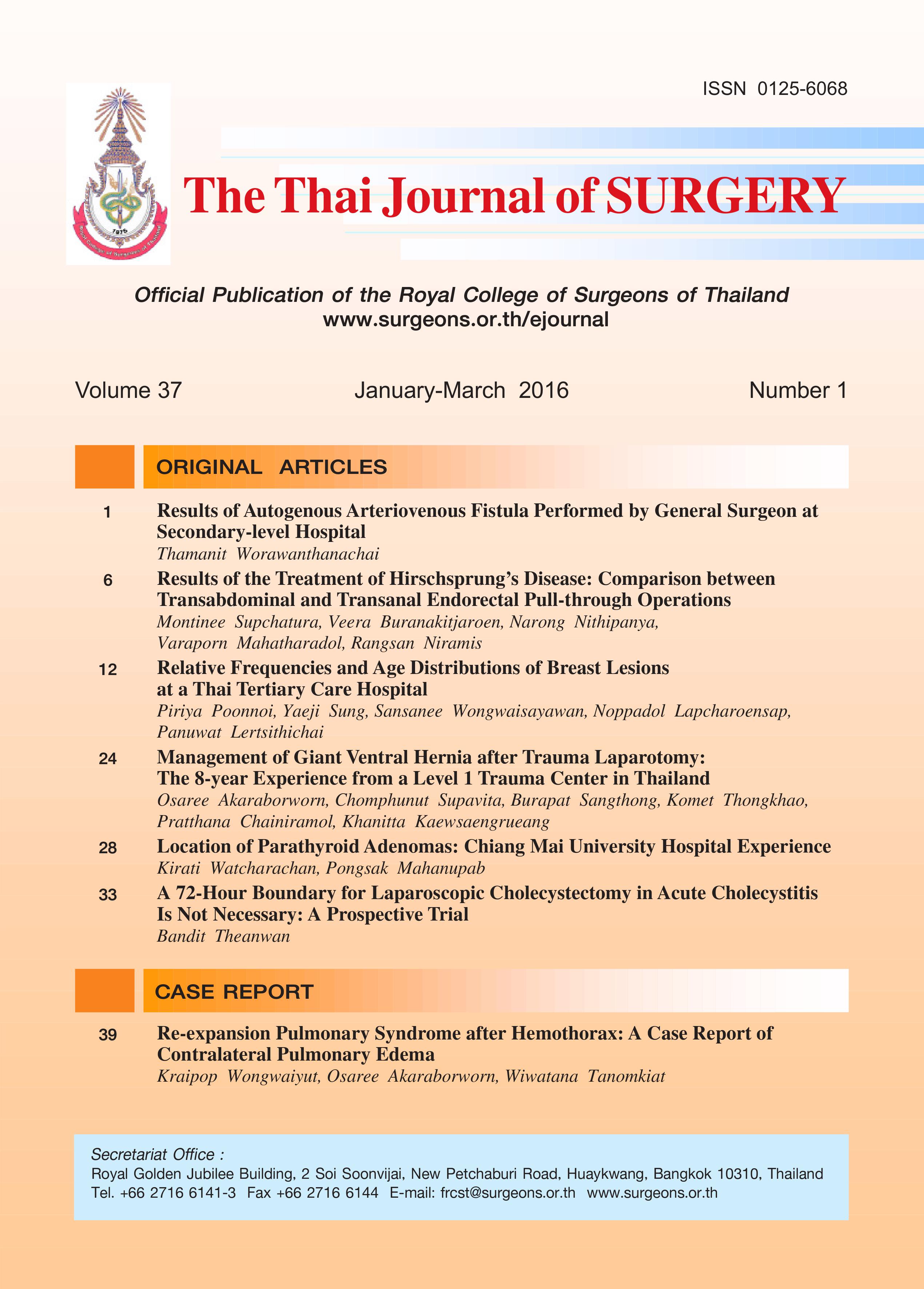Results of the Treatment of Hirschsprung’s Disease: Comparison between Transabdominal and Transanal Endorectal Pull-through Operations
Keywords:
Hirschsprung’s disease, abdominal pull-through operation, transanal endorectal pull-through, operation, results of treatment, enterocolitis, constipationAbstract
Background: Transabdominal pull-through operation has been established as the definitive treatment of Hirschsprung’s disease (HD) since 1948. One-stage transanal endorectal pull-through procedure is the latest evolution in the management of HD.
Objective: The aim of this study was to review the results of the treatment of HD by comparing between transabdomial and transanal endorectal pull-through operations.
Materials and Methods: Medical records of patients with HD who underwent definitive treatment between January 2007 and December 2012 at Queen Sirikit National Institute of Child Health were retrospectively reviewed. Patients who underwent transabdominal and transanal endorectal pull-through operations were categorized into groups A and B, respectively.
Results: of the two groups were compared using the Chi-square test, and a p-value less than 0.05 was considered statistically significant. Results: Of the 145 patients with HD, 86 (59%) were treated by transbdominal pull-through operation (group A), and 59 (41%) were treated by transanal pull-through procedure (group B). Age at operation ranged from 1.6 months to 12.7 years in group A and 21 days to 5.6 years in group B. One year after operation, normal defecation and continence were noted in 71% of patients in group A, and 70% in group B (p = 0.925). Constipation was more common in group A than that in group B (15% vs. 7%; p = 0.032). Anastomotic leakage (4%) and adhesive small bowel obstruction (4%) occurred in group A, but did not occur in group B. Only anastomotic stricture which required anal dilatation was more common in group B than that in group A, but with no statistical significance (9% vs. 4%; p = 0.267). The incidence of postoperative enterocolitis was not different between groups A (20%) and B (20%). There was no immediate postoperative death in both groups.
Conclusions: Operative outcomes from the present study revealed that transanal endorectal pull-through operation was better than the transabdominal procedure in terms of the low incidence of constipation, anastomotic leakage, postoperative small bowel obstruction and constipation. Occurrence of normal defecation and the incidence of postoperative enterocolitis were not different between the two techniques.
References
2. Swenson O, Bill AHJr. Resection of rectum and rectosigmoid with preservation of sphincter for benign spastic lesions producing megacolon: an experimental study. Surgery 1948;24:212-20.
3. Duhamel B. A new operation for the treatment of Hirschsprung’s disease. Arch Dis Child 1960;35:38-9.
4. Soave F. Hirschsprung’s disease: a new surgical technique. Arch Dis Child 1964;39:116-24.
5. De la Torre-Mondragon L, Ortega-Salgato JA. Trans-anal endorectal pull-through for Hirschsprung’s disease. J Pediatr Surg 1998;33:1283-6.
6. Niramis R, Watanatittan S, Anuntkosol M, et al. Quality of life of patients with Hirschsprung’s disease at 5-25 years post pull-through operation. Eur J Pediatr Surg 2008;33:38-43.
7. Holschneider AM. Hirschsprung’s disease. Stuttgart: Hippokrates, Thieme-Stratton; 1982.
8. Sherman JO, Snyder ME, Weitzman JJ, et al. A 40-year multinational retrospective study of 880 Swenson procedures. J Pediatr Surg 1989;24:233-8.
9. Bourdelet D, Visanaky P, Pages R, et al. Duhamel operation 40 years after: a multicentric study. Eur J Pediatr Surg 1997; 7:377-80.
10. Jasonni V, Martuciello G. Soave’s extramucosal endorectal pull-through procedure. In: Holschneider AM, Puri P, editors. Hirschsprung’s disease and allied disorders. London: Harwood Academic Publishers; 2000. p. 336-51.
11. Rescorla FJ, Morrison AM, Engles D, et al. Hirschsprung’s disease: evaluation of mortality and long - term function of 260 cases. Arch Surg 1992;127:934-42.
12. Moore SW, Albertyn R, Cywes S. Clinical outcome and long-term quality of life after surgical correction of Hirschsprung’s disease. J Pediatr Surg 1996;31:1496-502.
13. Yancher NL, Soucy P. Long-term outcome of Hirschsprung’s disease: patients’s perspective. J Pediatr Surg 1999;34:1152-60.
14. Albanese CT, Jennings RW, Smith B, et al. Perianal one-stage pull-through for Hirschsprung’s disease. J Pediatr Surg 1999; 34:377-80.
15. Shanker KR, Losty PD, Lamont GL. Transanal endorectal coloanal surgery for Hirschspung’s disease. Experience in two centers. J Pediatr Surg 2000;35:1209-13.
16. Teeraratkul S. Transanal one-stage endorectal pull-through for Hirschsprung’s disease in infants and children. J Pediatr Surg 2003;38:184-7.
17. Hadidi A. Transanal endorectal pull-through for Hirschsprung’ s disease: experience with 68 patients. J Pediatr Surg 2003; 38:1337-40.
18. Langer JC, Durrant AC, De la Torre-Mondragon L, et al. Onestage transanal Soave pull-through for Hirschsprung’s disease: a multicenter experience with 141 children. Ann Surg 2003;238:569-83.
19. De la Torre-Mondragon L, Ortega-Salgato JA. Transanal versus open endorectal pull-through for Hirschsprung’s disease. J Pediatr Surg 2000;35:1630-2.
20. Hadidi A. Transanal endorectal pull-through for Hirschsprung’s disease: a comparison with the open technique. Eur J Pediatr 2003;13:176-80.
21. Aslanabadi S, Ghalehgolab-Behbahan A, Zarrintan S, et al. Transanal one-stage endorectal pull-through for Hirschsprung’s disease: a comparison with the staged procedure. Pediatr Surg Int 2008;24:925-9.
22. Tannuri AC, Tannuri U, Romao RL. Transanal endorectal pullthrough in children with Hirschsprung’s disease – technical refinements and comparison of results with the Duhamel procedure. J Pediatr Surg 2009;44:767-72.
23. Buranakitjaroen V, Mahatharadol V. An experience with 53 patients of transanal endorectal pull-through for Hirschsprung’s disease. Chula Med J 2011;55:611-20.
24. Gao Y, Zhang Q,Xu Q, et al. Primary transanal rectosigmoidectomy for Hirschsprung’s disease: preliminary results in the initial 33 cases. J Pediatr Surg 2001;36:1816-9.
25. Teitelbaum DH, Coran AG. Primary pull-through for Hirschsprung’s disease. Semin Neonatol 2003;8:233-41.
Downloads
Published
How to Cite
Issue
Section
License
Articles must be contributed solely to The Thai Journal of Surgery and when published become the property of the Royal College of Surgeons of Thailand. The Royal College of Surgeons of Thailand reserves copyright on all published materials and such materials may not be reproduced in any form without the written permission.



